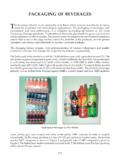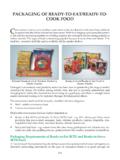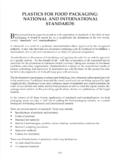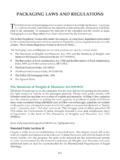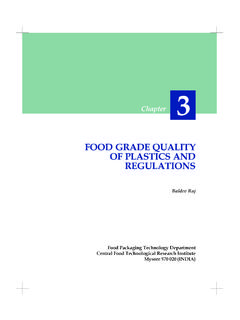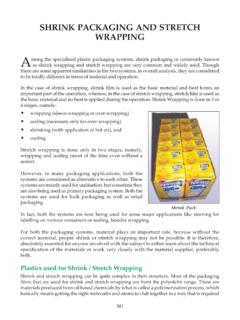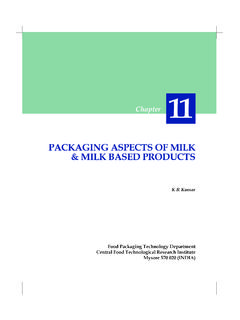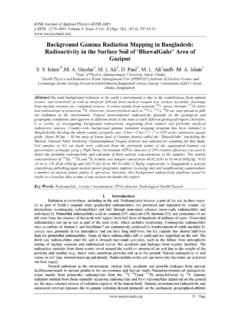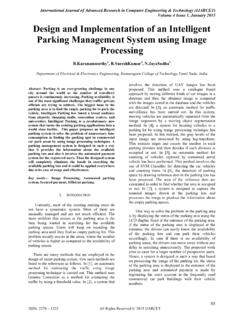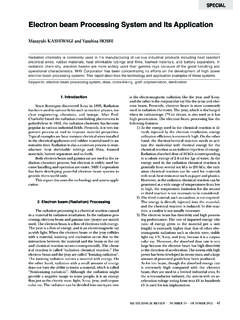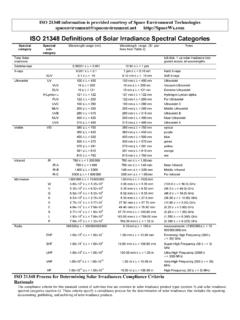Transcription of ASEPTIC PACKAGING SYSTEM - Indian Centre for …
1 309 ASEPTIC PACKAGING SYSTEMA septic PACKAGING can be defined as the filling of a commercially sterile product into asterile container under ASEPTIC conditions and hermetically sealing the containers so thatreinfection is prevented. This results in a product, which is shelf-stable at ambient term ASEPTIC is derived from the Greek word septicos which means the absence ofputrefactive practice, generally there are twospecific fields of application ofaseptic PACKAGING technology: PACKAGING of pre-sterilisedand sterile are milk and dairyproducts, puddings,desserts, fruit and vegetablejuices, soups, sauces, andproducts with particulates. PACKAGING of non-sterileproduct to avoid infection bymicro-organisms. Examples of this application include fermented dairy products PACKAGING technology is fundamentally different from that of conventional foodprocessing by canning. In canning, the process begins with treating the food prior to operations inactivate enzymes so that these will not degrade the product duringprocessing.
2 The package is cleaned, and the product is introduced into the package, usually , air that can cause oxidative damage is removed from the interior. The package ishermetically sealed and then subjected to heating. The package must be able to withstand heatup to about 100 C for high acid products and up to 127 C for low acid products, which mustreceive added heat to destroy heat-resistant microbial spores. Packages containing low-acid(above pH ) food must withstand pressure as conventional canning renders food products commercially sterile, the nutritionalcontents and the organoleptic properties of the food generally suffer in the processing . Moreover,tinplate containers are heavy in weight, prone to rusting and are of high 1 is a simple illustration comparing the basic difference between conventional canningand ASEPTIC PACKAGING processes for the production of shelf-stable of ASEPTIC PACKAGING TechnologyThe three main advantages of using ASEPTIC PACKAGING technology are: PACKAGING materials, which are unsuitable for in-package sterilisation can be , light weight materials consuming less space offering convenient featuresMilk in ASEPTIC Pack310 Figure 1: Conventional Canning v/s ASEPTIC PackagingProductFillingSealingRetort ProcessingCoolingStorage/DistributionPro ductHTST ProcessingCoolingFillingSealingStorage/D istributionPackageSterilizationPackagean d with low cost such as paper and flexible and semi-rigid plastic materials can beused gainfully.
3 Sterilisation process of high-temperature-short time (HTST) for ASEPTIC PACKAGING isthermally efficient and generally gives rise to products of high quality and nutritivevalue compared to those processed at lower temperatures for longer time. Extension of shelf-life of products at normal temperatures by packing the features mentioned above, additional advantages are that the HTST process utilisesless energy, as part of the process-heat is recovered through the heat exchangers and the asepticprocess is a modern continuous flow process needing fewer processing MethodologyAseptic processing comprises the following: Sterilisation of the products before filling Sterilisation of PACKAGING materials or containers and closures before filling Sterilisation of ASEPTIC installations before operation (UHT unit, lines for products, sterileair and gases, filler and relevant machine zones)Conventional Process FlowAseptic Process Flow311 Maintaining sterility in this total SYSTEM during operation.
4 Sterilization of all media enteringthe SYSTEM , like air, gases, sterile water Production of hermetic packagesSterilization of ProductsIn ASEPTIC processing , the design to achieve commercial stability is based on the well-foundedprinciples of thermal bacteriology and integrated effect of time/temperature treatment onspores of of a product usually consists of heating the product to the desired UHTtemperature, maintaining this temperature for a given period in order to achieve the desireddegree of sterility, with subsequent cooling, usually to ambient temperature and sometimesto an elevated temperature to achieve right viscosity for filling. Heating and cooling shouldbe performed as rapidly as possible to achieve the best quality, depending upon the natureof the product. A fast heat exchange rate is desired for cost heat transfer methods are used, but essentially the systems can be divided into directand indirect heat exchange 1 summarizes the characteristics of the heat exchange systems used for ASEPTIC processingof 1 Characteristics of the Heat Exchange SystemsUsed for ASEPTIC processing of LiquidsEquipmentProduct AromaEnergy CapitalSpace PulpFoulingTurn- TypeQuality Reten- Saving CostCapabi- Length down*tionlityof RunSteamExcellent NoPoorHighFairFair-Excellent FairInjection/GoodInfusionPlate HeatGoodYesExcellent LowExcellent Limited Limited GoodExchangerTubular.
5 Small Tubes Medium YesFairMedium GoodGood Limited Good Large Tubes PoorYesFairLowFairGood GoodGoodSweptGoodYesVeryVeryHighFair-Goo dGoodSurfacePoorHighGood(* Turndown is the capability of the SYSTEM to process at different rates to accommodate differentnumber of fillers or different package sizes.)[Source : Dinnage (1983)]312 Some of the latest methods of sterilisation of products include: Microwaves Electrical resistance heating High voltage discharge Ultra high pressureSterilisation of ASEPTIC PACKAGING Materials and Equipment Sterilisation Agents: Heat, chemicals and radiation have been used, alone or incombination, for sterilization of ASEPTIC equipment and PACKAGING materials. Practicalconsiderations and regulatory requirements have limited the number of sterilants, whichare used for ASEPTIC systems. HeatInitially, heat was used as the sterilant for ASEPTIC systems as a natural extension of thermalprocessing.
6 Product supply lines and fillers are commonly sterilized by moist heat in theform of hot water or saturated steam under pressure. Dry heat, in the form of superheatedsteam or hot air, may also be used to sterilize equipment. However, due to the relatively highdry heat resistance of bacterial endospores, the time-temperature requirements for dry heatsterilization are considerably higher than those for moist heat , relatively large masses of metal are often present in ASEPTIC filling and packagingsystems, high temperatures and relatively long holding periods are necessary to assurethat appropriate sterilization has occurred. Systems employing moist heat are frequentlysterilized at temperatures ranging from 121 C to 129 C, while 176 C to 232 C is usedfor sterilization by dry heat. In addition, sterilization of air by incineration usually isconducted at temperatures ranging from 260 C to 315 C. ChemicalsHydrogen peroxide is the overwhelming choice for use as a chemical sterilant.
7 Otherchemicals which have been used as sterilants, primarily for use in systems for acidfood, include various acids, ethanol, ethylene oxide and peracetic peroxide is not an efficient sporicide when used at room temperature. However,the sporicidal activity increases substantially with increasing temperatures. Therefore,most ASEPTIC PACKAGING systems use hydrogen peroxide (at concentrations of 30 to 35%)as a sterilant for PACKAGING materials followed by hot air (60 C to 125 C) to dissipateresidual hydrogen peroxide. RadiationGamma-radiation has been used for decades to decontaminate PACKAGING materials foruse in ASEPTIC systems for packing acid and acidified food. Due to the penetratingpowers of gamma-radiation, packages are treated in bulk at commercial irradiators. Adose of approximately Megaradians (Mrad) is commonly used to decontaminatecontainers for acid and acidified food. Recently, processes for low acid food asepticfilling and PACKAGING systems are also being accepted.
8 Doses required to sterilizecontainers for use with low acid food are considerably higher than those required foracid and acidified types of radiation are not widely used in ASEPTIC systems. Ultraviolet (UV-C) lighthas been used to decontaminate food contact surfaces. The low penetration and problems313associated with shadowing , limit the use of UV-C for ASEPTIC systems PACKAGING oflow acid food. While equipment size, speed and costs have precluded use ofelectron beam irradiators until now; it is only a matter of time before such a SYSTEM Once the product has been brought to the sterilisation temperature, it flows into a holdingtube. The tube provides the required residence time at the sterilisation temperature. Theprocess is designed to ensure that the fastest moving particle through the holding tube willreceive a time/temperature process sufficient for sterilisation. Since there is some loss oftemperature as product passes through the holding tube, the product temperature must besufficiently high on entering, so that even with some temperature drop, it will still at leastbe at the prescribed minimum temperature at the exit of the holding tube.
9 No externalheating of the holding tube should take place. A deaerator is used to remove air, as most products, which are aseptically processed, mustbe deaerated prior to PACKAGING . The air is removed to prevent undesirable oxidativereactions, which occur as the product temperature is increased during the process. Thedeaerator generally consists of a vessel in which the product is exposed to a vacuum on acontinuous flow. The sterilised product is accumulated in an ASEPTIC surge tank prior to PACKAGING . Thevalve SYSTEM that connects the surge tank between the end of the cooling section and thepackaging SYSTEM , allows the processor to carry out the processing and packagingfunctions more or less independently. The product is pumped into the surge tank and isremoved by maintaining a positive pressure in the tank with sterile air or other sterilegas. The positive pressure must be monitored and controlled to protect the tank Brik AsepticTetra Brik ASEPTIC withSpin CapTetra RexSeals and ClosuresAny ASEPTIC SYSTEM must be capable of closing and/or sealing the package hermetically tomaintain sterility during handling and distribution.
10 The integrity of the closure and seal istherefore of paramount importance. The integrity of the heat-seals used in most aseptic314 Figure 2: Sealingssystems is principally influenced by the efficiency of the sealing SYSTEM used and bycontamination of the heat seal area by the product. To avoid recontamination, the productionunits, which are tight are required. Two systems are manufactured in the Tetrapak SYSTEM -the longitudinal and the transverse the longitudnal SYSTEM , a flat web of PACKAGING material is used, supplied in reels. Thisflat material web is formed into a tube, which is sealed longitudinally resulting in a cylindershaped structure. The strength of this longitudinal seam is determined partly by an overlapseal and partly by a plastic longitudinal strip. This strip is first sealed to one edge of thepackaging material web and once the PACKAGING material tube has been formed sealed tothe inner surface of the PACKAGING material.
